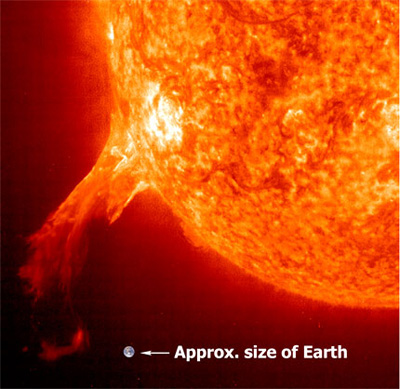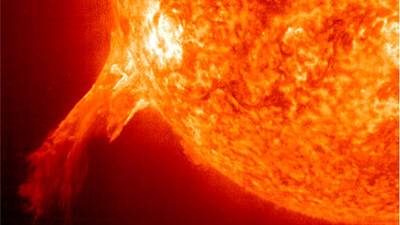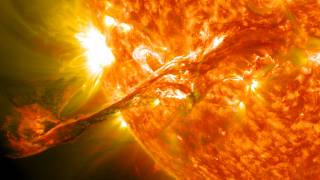Massive Solar Flare Storm Warnings for the Next Few Years
Source: nydailynews.com
 According to a new report, the United States is in danger of a massive space storm that could knock out power to much of the nation.
According to a new report, the United States is in danger of a massive space storm that could knock out power to much of the nation.It may sound like the premise for the next Michael Bay, big-budget action extravaganza -- but scientists say a storm from space could change life on Earth as we know it.
And the United States is woefully unprepared for such a disaster, according to a new report.
The potential threat, detailed in a National Academy of Sciences, Severe Space Weather Events report, said radiation bombarding the planet from powerful solar flares could result in the loss of power, water and communications on a global scale.
"It's very likely in the next 10 years that we will have some impact like that described in the National Academy report," Dr. Richard Fisher, director of NASA's heliophysics division, told the Daily News. "Although I don't know to what degree."
Fisher explained that the sun works on an 11-year cycle, and is now emerging from its quiet period.
The next phase -- the solar maximum -- lasts from 2012 to 2015. During this period of time, massive solar flares and coronal mass ejections (CMEs) can occur which could be strong enough to knock out satellites, disable high-voltage transformers, and cripple communications worldwide.
Doug Biesecker, top solar physicist at the National Oceanic and Atmospheric Administration (NOAA), told the News severe solar storms have occurred in the past. The strongest was in 1859, and rendered telegraph machines useless. Another slightly smaller geomagnetic storm occurred in 1921.
"If the 1921 storm happened today, it would knock out power from Maine to Georgia," Biesecker said. It would affect "130 million people and 350 transformers."
Transformers, he noted, can take over a year to fix and are not made in the U.S.
"This raises all kinds of geopolitical issues," said John Kappenman, a principal of Storm Analysis Consultants and the lead technical expert for a study conducted by the Metatech Corp. on the potential impact of solar storms.
"If the blackout affected more than one country, the U.S. would not necessarily be the first in line to get one," he said, noting that transformers are made in Europe, Brazil, China and India.
In addition, it would take a well-trained crew to install new transformers, which weigh more than 100 tons and would need to be shipped via ocean liners.
Just getting them here "could drag on for several weeks if the transportation sector is compromised," Kappenman said.
Unlike a hurricane, Kappenman said the aftermath of a solar storm could be widespread, with 50% to 75% of the country affected. "We could have a blackout like never before," he said. It took only a few days to get back to normal after the 1977 or 2003 blackouts. "This time, you might not get back to normal at all."
There would also likely be no immediate help from neighboring areas, and big cities such as New York would be hit especially hard "You couldn't evacuate," he said. "Where do you put 8 million people?"
A severe blackout would have rapidly deteriorating effects. Without electricity, there would be a loss of potable water and the ability to pump sewage. Perishable food and medication would be lost.
"There are one million type 1 diabetes sufferers in the U.S.," he said. "Health issues would emerge in just a matter of days."
Telecommunications have a backup for about 72 hours before they degrade. Similarly, hospitals have about a week's worth of backup power. Nuclear reactors typically have a week of standby diesel fuel. Even if they shut down, they still require electricity to circulate cooling water through the reactor. "This could be a serious problem for 70 or so large reactors," Kappenman said.
"We obsess over oil," said Kappenman, "but electricity is twice as important."
An even a smaller storm could still wreak havoc. GPS satellites are particularly vulnerable to solar flares. Loss of a satellite could lead to problems with airline flights and communications. Computer systems measure time using GPS.
Oil rigs use GPS and water jets to maintain their offshore position as they drill. "They could drop off," said Biesecker, "and break a pipe."
"CMEs are like high-energy electromagnetic pulses [HEMP]," he explained. The use of HEMP - its force equivalent to an atomic bomb - by terrorists was the subject of a recent congressional hearing in Washington. "FEMA and other organizations are also looking at what a possible terror attack could do to the grid," he noted.
On June 10, the House of Representatives unanimously passed the Grid Reliability and Infrastructure Defense Act. It amends the Federal Power Act to protect the nation's power system against "cybersecurity and other threats and vulnerabilities." A similar bill has yet to be taken up by the Senate.
Source: nydailynews.com






















